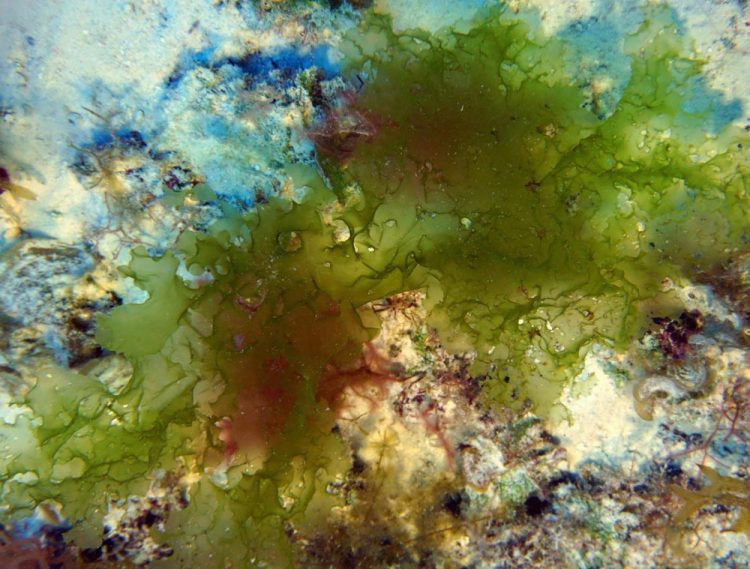Four new algae species discovered in Hawaii's deep waters

New species of deep-water algae was photographed by a SCUBA diver at 200 feet at Kure Atoll in Papahanaumokuakea Marine National Monument. Credit: Daniel Wagner/NOAA
Heather Spalding, Ph.D., postdoctoral researcher at the University of Hawaii Department of Botany and lead author of the study, said, “I was astounded at the abundance and size of these algae, which resembled something you would see in a shallow-water lagoon, not at 400 feet.”
Spalding has been collaborating with NOAA's Office of National Marine Sanctuaries for several years studying samples collected by NOAA divers working in Papahanaumokuakea Marine National Monument. She and her colleagues at the University of Hawaii and University of Washington's Friday Harbor Laboratories conducted DNA analyses that showed that the species are very different than those found in Hawaii's shallow waters, even though they are very similar in appearance.
“If you picked up one of these algae on the beach, you couldn't tell if it was from a nearby rock or washed up from the deep, the species look that similar,” Spalding said.
The newly discovered species are similar in appearance to limu palahalaha (Ulva lactuca), or sea lettuce. Scientists consulted with the Native Hawaiian community to develop meaningful names for the new species to honor the great importance they have in Hawaiian culture. One species was named Ulva iliohaha, which refers to the foraging behavior of ilioholoikauaua, the endangered Hawaiian monk seal, one of the best-known residents of Papahanaumokuakea.
The species were sampled during surveys between 2013 and 2015 in Papahanaumokuakea Marine National Monument by NOAA divers using advanced SCUBA diving technologies, and during past NOAA expeditions from 2006 to 2014 throughout the Main Hawaiian Islands using submersibles operated by the Hawaii Undersea Research Laboratory. Scientists anticipate that many additional new species of algae will be described in the coming years from samples collected by NOAA divers on future expeditions to the monument.
“These findings redefine our understanding of algal distributions in Hawaii, and hint at the great number of other new species that are likely to be discovered in the future from these amazing deep-water reefs,” said Daniel Wagner, Papahanaumokuakea research specialist with NOAA's Office of National Marine Sanctuaries.
###
The study describing the new species of limu was published in the latest issue of the Journal of Phycology. The article, titled “New Ulvaceae (Ulvophyceae, Chlorophyta) from mesophotic ecosystems across the Hawaiian Archipelago,” is featured as the journal's cover story and can be accessed in its entirety at http://onlinelibrary.
Images are available at http://sanctuaries.
Papahanaumokuakea is cooperatively managed to ensure ecological integrity and achieve strong, long-term protection and perpetuation of Northwestern Hawaiian Island ecosystems, Native Hawaiian culture, and heritage resources for current and future generations. Three co-trustees – the Department of Commerce, Department of the Interior, and State of Hawaii – joined by the Office of Hawaiian Affairs, protect this special place. Papahanaumokuakea Marine National Monument was inscribed as the first mixed (natural and cultural) UNESCO World Heritage Site in the United States in July 2010. For more information, please visit http://www.
Media Contact
All latest news from the category: Life Sciences and Chemistry
Articles and reports from the Life Sciences and chemistry area deal with applied and basic research into modern biology, chemistry and human medicine.
Valuable information can be found on a range of life sciences fields including bacteriology, biochemistry, bionics, bioinformatics, biophysics, biotechnology, genetics, geobotany, human biology, marine biology, microbiology, molecular biology, cellular biology, zoology, bioinorganic chemistry, microchemistry and environmental chemistry.
Newest articles

Silicon Carbide Innovation Alliance to drive industrial-scale semiconductor work
Known for its ability to withstand extreme environments and high voltages, silicon carbide (SiC) is a semiconducting material made up of silicon and carbon atoms arranged into crystals that is…

New SPECT/CT technique shows impressive biomarker identification
…offers increased access for prostate cancer patients. A novel SPECT/CT acquisition method can accurately detect radiopharmaceutical biodistribution in a convenient manner for prostate cancer patients, opening the door for more…

How 3D printers can give robots a soft touch
Soft skin coverings and touch sensors have emerged as a promising feature for robots that are both safer and more intuitive for human interaction, but they are expensive and difficult…





















